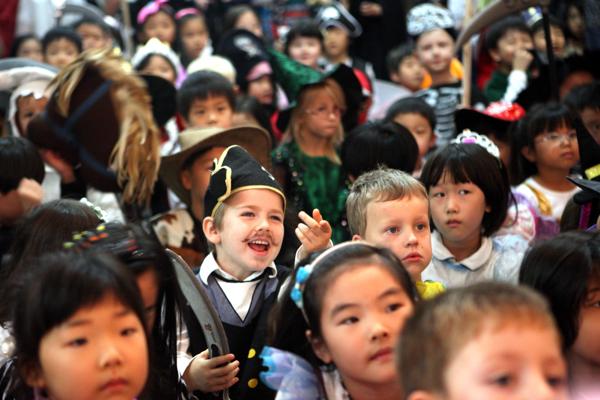
Students attend a Halloween party at Rainbow Bridge International School in Shanghai.[Photo/China Daily]
The change in policy toward the international divisions at public high schools, announced in April last year, has sent a shock wave through the high school education sector.
With the international divisions at public high schools facing the risk of being shut down, private schools providing international curricula expect a boom, said Gui Chun, founder and chief executive officer of DK Education, a Beijing-based education consulting company that provides an international education service to public high schools.
“Our business has experienced severe shrinkage since the policy was announced. Many schools have stopped developing international divisions, sitting still and waiting for further policy instructions, while other schools have already cut their international programs,” Gui said.
However, as a former SAT teacher, Gui does not mourn the decline of part of his business. He is excited to see an opportunity for private schools.
“It will be the market’s call now,” he said. “Fair competition is about to begin.”
Andi O’Hearn, director of University Counseling and Enrollment Management of Beijing City International School, one of the city’s international schools that is allowed to enroll Chinese students, said: “The government decision will be closely watched with interest by all schools.”
Effects uncertain
Since the policy remains unclear, O’Hearn found it difficult to estimate how the changes might affect international schools.
“If the government decides to close international divisions at public high schools and allow more international schools to enroll Chinese students, it will create a lot of competition for Chinese students, and have a large number looking for international education. It will completely change the landscape for international schools,” she said.
In the policy released last year, the Beijing Education Commission stopped issuing new international divisions at public high schools in the capital. Other cities, including Shanghai, Guangzhou, Wuhan and Shenzhen, have also tightened their policies on international divisions at public high schools and reduced recruitment.
Sheng Jianxue, then-deputy director of the Department of International Cooperation and Exchanges at the Ministry of Education, said in 2013 that the ministry would implement strict policies on the international divisions at public high schools.
During the annual two sessions in March, deputies of the National People’s Congress and members of the Chinese People’s Political Consultative Conference called for a change for the international divisions at public high schools.
For domestic students
Compared with international schools in China, which are usually designed to serve children of expatriates with a proficiency in English, the international divisions at public high schools are designed for, and driven by, domestic students who wish to study at overseas universities, according to an April report by Wang Ming, a researcher at the National Center for Education Development Research at the Ministry of Education.
Figures from the Ministry of Education show that 459,800 Chinese students went abroad for education last year.
In order to study at a foreign university, students need to prepare in high school.
The emergence of the international divisions at public high schools has catered to a growing need in the past decade among Chinese students pursuing undergraduate education overseas.
According to a survey last year by eol.cn, China’s largest education portal, 22 international classes were run by 17 public high schools in Beijing by the end of 2013. In 2009, there were only nine international classes in Beijing’s public high schools. Student enrollment also increased from 440 in 2009 to 1,355 in 2013.
Exploration
However, Wang Hongjun, deputy head of Beijing No 35 High School, said she does not see the international programs in public high schools as a cash cow but rather an educational exploration to better assist education reform.
“People against international programs have an inaccurate understanding of them,” Wang said. “The Beijing Education Commission is very careful with the overseas curricula, aiming to bring high-quality international curricula to China’s education reform.”
Quick facts
• Last year, 459,800 Chinese went abroad to study
• 274,439 Chinese studied in the United States in the 2013-14 academic year, accounting for 31 percent of international students in the US
• 110,550 Chinese studied as undergraduates in the US in the 2013-14 academic year
• In 2009, there were nine international classes in Beijing’s public high schools; in 2013, there were 22
• In 2009, there were 440 students in the international divisions of public high schools in Beijing; in 2013, 1,355 students enrolled in the international divisions
• Annual tuition fees for international divisions in Beijing range from 80,000 to 100,000 yuan ($12,900 to $16,100)
• Regular annual tuition fees for public high schools: 800 yuan
Sources: Ministry of Education, 2014 Open Doors Report, eol.cn
